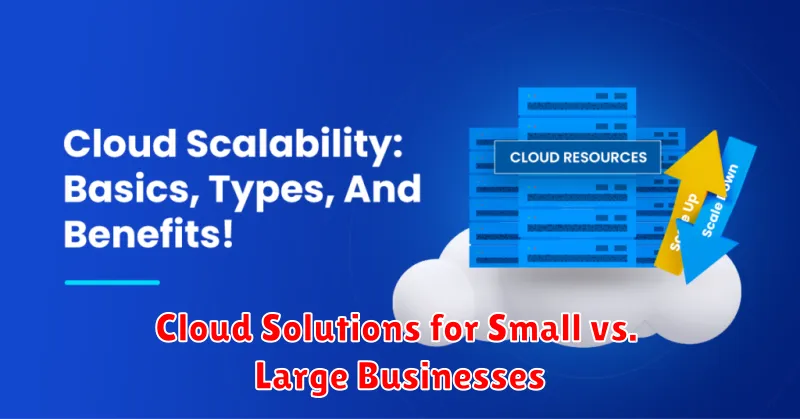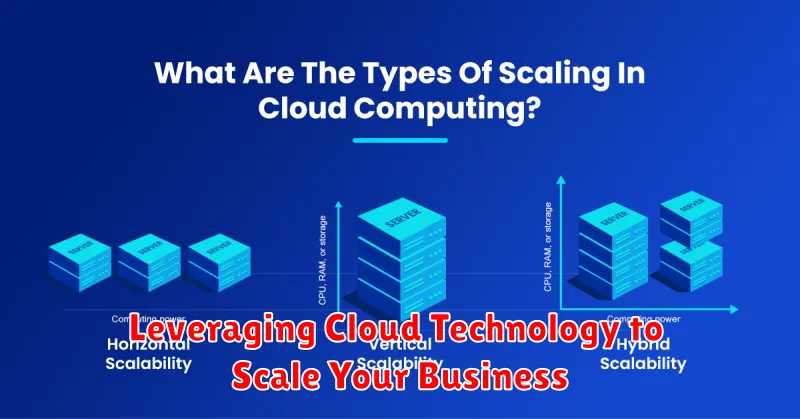In today’s rapidly evolving business landscape, scalability is paramount to success. Businesses must be able to adapt to changing market demands, accommodate growth spurts, and efficiently manage resources. Cloud technology offers a powerful solution, providing the flexibility and scalability necessary to navigate these challenges and achieve sustainable growth. This article explores the myriad benefits of leveraging cloud technology to scale your business operations, from enhancing efficiency and reducing costs to improving agility and fostering innovation.
Cloud computing empowers businesses to scale their resources up or down on demand, eliminating the need for significant upfront investments in hardware and infrastructure. This elasticity enables businesses to respond quickly to market fluctuations and optimize resource allocation, leading to cost savings and improved operational efficiency. By leveraging cloud-based solutions, businesses can streamline their processes, enhance collaboration, and unlock new opportunities for growth and innovation. Discover how cloud technology can transform your business and propel it towards greater success.
What is Cloud Technology?
Cloud technology refers to the on-demand availability of computer system resources, especially data storage (cloud storage) and computing power, without direct active management by the user. Instead of owning and maintaining physical data centers and servers, organizations can access technology services, such as computing power, storage, and databases, on an as-needed basis from a cloud provider like Amazon Web Services (AWS), Microsoft Azure, or Google Cloud Platform (GCP).
Essentially, cloud computing allows companies to rent access to these resources rather than owning them outright. This offers significant flexibility and scalability, allowing businesses to quickly adjust their resource consumption based on demand.
Benefits of Cloud Adoption for Businesses
Cloud adoption offers numerous advantages for businesses of all sizes. Cost savings are a primary driver, eliminating the need for extensive hardware investments and reducing IT infrastructure costs. Cloud solutions also provide scalability, allowing businesses to easily adjust resources based on demand, avoiding costly over-provisioning.
Increased efficiency is another key benefit. Cloud services streamline operations, automate tasks, and enable remote work, boosting productivity. Enhanced security is often achieved through advanced security measures employed by cloud providers. Finally, cloud adoption fosters innovation by providing access to cutting-edge technologies and enabling rapid development and deployment of new applications and services.
Cloud Solutions for Small vs. Large Businesses

Small businesses often benefit from the scalability and cost-effectiveness of cloud solutions. Popular choices include pre-packaged software-as-a-service (SaaS) offerings for functions like customer relationship management (CRM), email marketing, and file storage. These solutions typically require minimal upfront investment and offer pay-as-you-go pricing.
Large enterprises, on the other hand, might require more complex and customized cloud deployments. They may leverage Infrastructure-as-a-Service (IaaS) to build and manage their own applications in the cloud or combine various cloud services to meet specific business needs. Security, compliance, and integration with existing systems are key considerations for large organizations.
Security Considerations in the Cloud
Migrating to the cloud offers numerous benefits, but also introduces new security challenges. Data protection is paramount. Understanding the shared responsibility model is crucial. Cloud providers are responsible for securing the underlying infrastructure, while you are responsible for securing your data and applications residing within that infrastructure.
Access control is another key concern. Implement strong password policies, multi-factor authentication, and principle of least privilege to limit access to sensitive data. Regularly audit user permissions and activity logs to detect and respond to potential threats.
Data encryption both in transit and at rest is essential to protect against unauthorized access. Vulnerability management is an ongoing process. Stay informed about security patches and updates, and implement them promptly. Consider penetration testing and vulnerability scanning to proactively identify and address weaknesses.
Cost Efficiency and Budgeting
Cloud technology offers significant cost advantages over traditional on-premise infrastructure. By migrating to the cloud, businesses can eliminate the capital expenditures associated with purchasing and maintaining hardware. This translates to reduced upfront costs and predictable operational expenses through a subscription-based model.
Budgeting becomes more streamlined with cloud computing. The pay-as-you-go model allows businesses to scale resources up or down as needed, paying only for what they consume. This flexibility allows for better cost control and optimization, preventing overspending on unused capacity.
Choosing Between Public, Private, and Hybrid Cloud
Selecting the right cloud deployment model is crucial for maximizing the benefits of cloud technology. The three primary options—public, private, and hybrid cloud—each offer distinct advantages and disadvantages.
Public clouds, offered by third-party providers, provide scalability and cost-effectiveness, making them ideal for fluctuating workloads. Private clouds, dedicated to a single organization, offer enhanced security and control, suitable for sensitive data and regulatory compliance. Hybrid clouds combine public and private resources, allowing businesses to leverage the strengths of both, optimizing cost and security.
Factors to consider when choosing include budget, security requirements, compliance needs, and IT expertise. Careful evaluation of these factors against each deployment model’s characteristics will guide you towards the optimal solution for your business.
Data Backup and Disaster Recovery
Cloud technology offers robust solutions for data backup and disaster recovery. Regular, automated backups ensure business continuity by protecting against data loss due to hardware failure, human error, or cyberattacks.
Cloud-based disaster recovery allows for quick recovery times and minimizes downtime. This involves replicating critical systems and data in a separate cloud environment, allowing businesses to quickly resume operations in case of a disaster.
The scalability of cloud resources enables businesses to easily adjust backup and recovery capabilities as their needs evolve, ensuring cost-effectiveness and optimal data protection.
Migrating Your Operations to the Cloud
Migrating to the cloud is a significant undertaking that requires careful planning and execution. A phased approach is often recommended, allowing you to transition smoothly and minimize disruption. Assessment of your current infrastructure and applications is the crucial first step.
This involves identifying which systems are suitable for cloud migration and which require adjustments. Considerations include compatibility, security requirements, and performance needs. Choosing the right cloud deployment model (public, private, or hybrid) is also a critical decision.
Implementation involves migrating data and applications, configuring the cloud environment, and testing thoroughly. Post-migration, ongoing management and optimization are essential to ensure continued efficiency and cost-effectiveness.
Monitoring and Managing Cloud Resources
Effectively monitoring and managing your cloud resources is crucial for successful scaling. This involves tracking performance, ensuring security, and optimizing costs.
Key aspects of cloud resource management include establishing clear resource tagging policies, implementing robust monitoring tools, and utilizing automation where possible. This allows for better cost control, enhanced security posture, and improved performance visibility.
Regularly reviewing resource utilization helps identify areas for optimization. This can involve right-sizing instances, deleting unused resources, and leveraging automation to scale resources based on demand.
Future of Cloud in Business Technology

The future of cloud computing in business is marked by continued growth and transformation. Several key trends will shape this evolution.
Serverless computing will become more prevalent, abstracting away server management entirely. Edge computing will bring computation and data storage closer to the source of data, enabling faster processing and reduced latency. The increasing sophistication of artificial intelligence (AI) and machine learning (ML) will further drive cloud adoption, with cloud platforms offering powerful tools and resources for developing and deploying AI/ML solutions.
Enhanced security measures will become increasingly critical, addressing growing concerns about data breaches and cyberattacks. The cloud will also facilitate greater collaboration and integration across businesses, fostering more agile and efficient operations.

